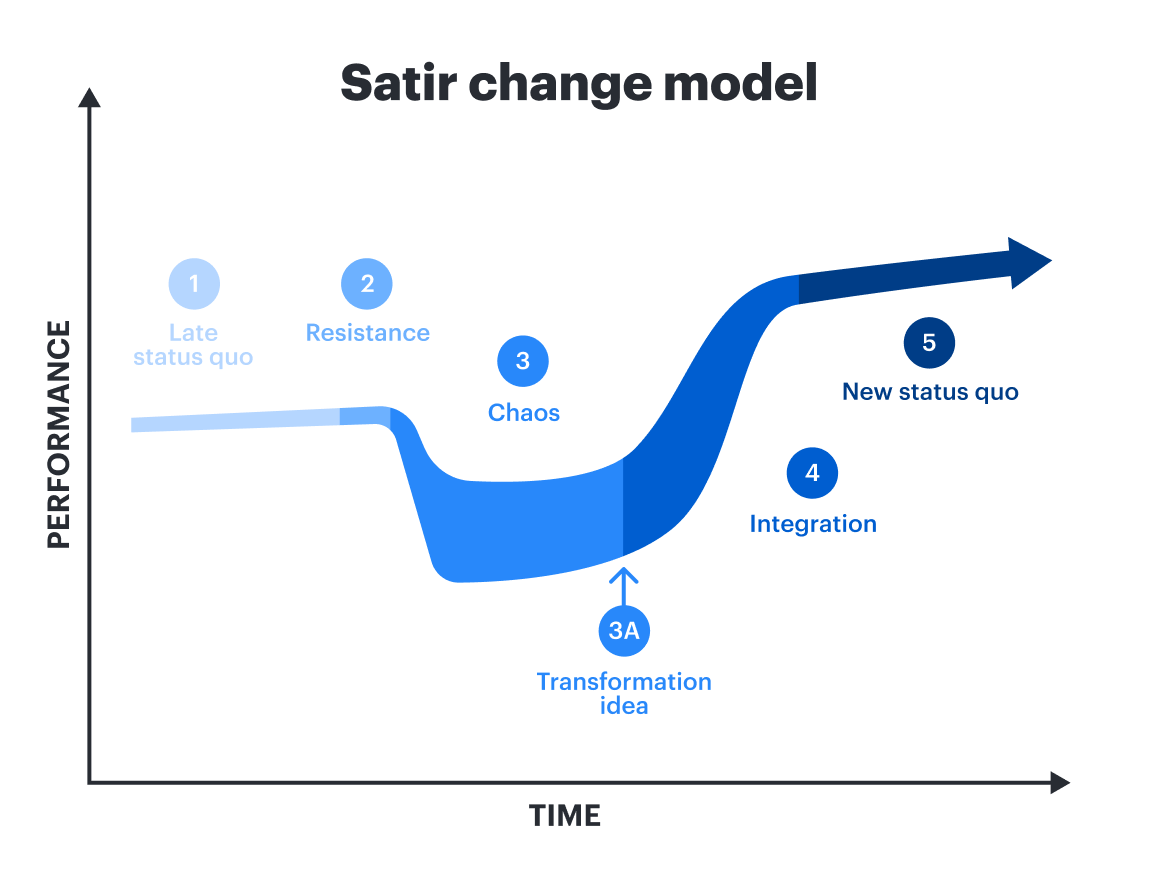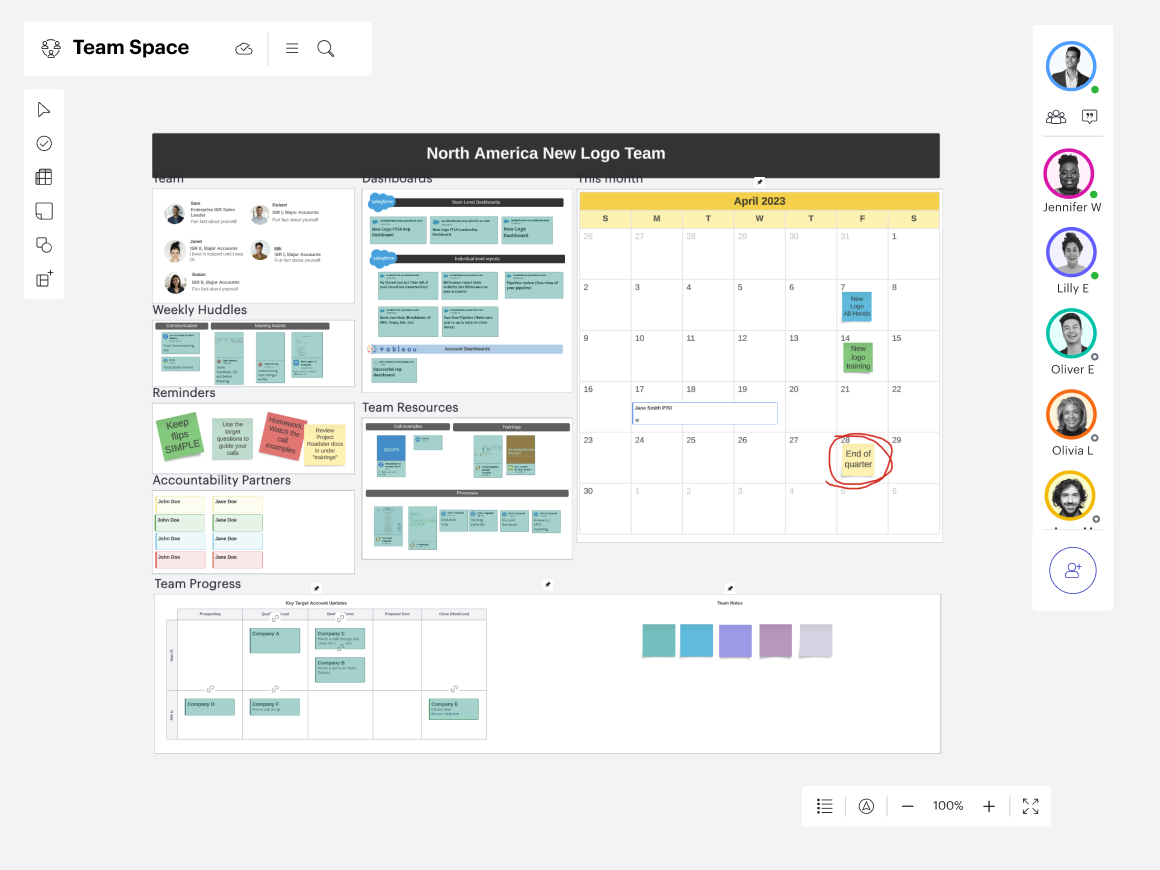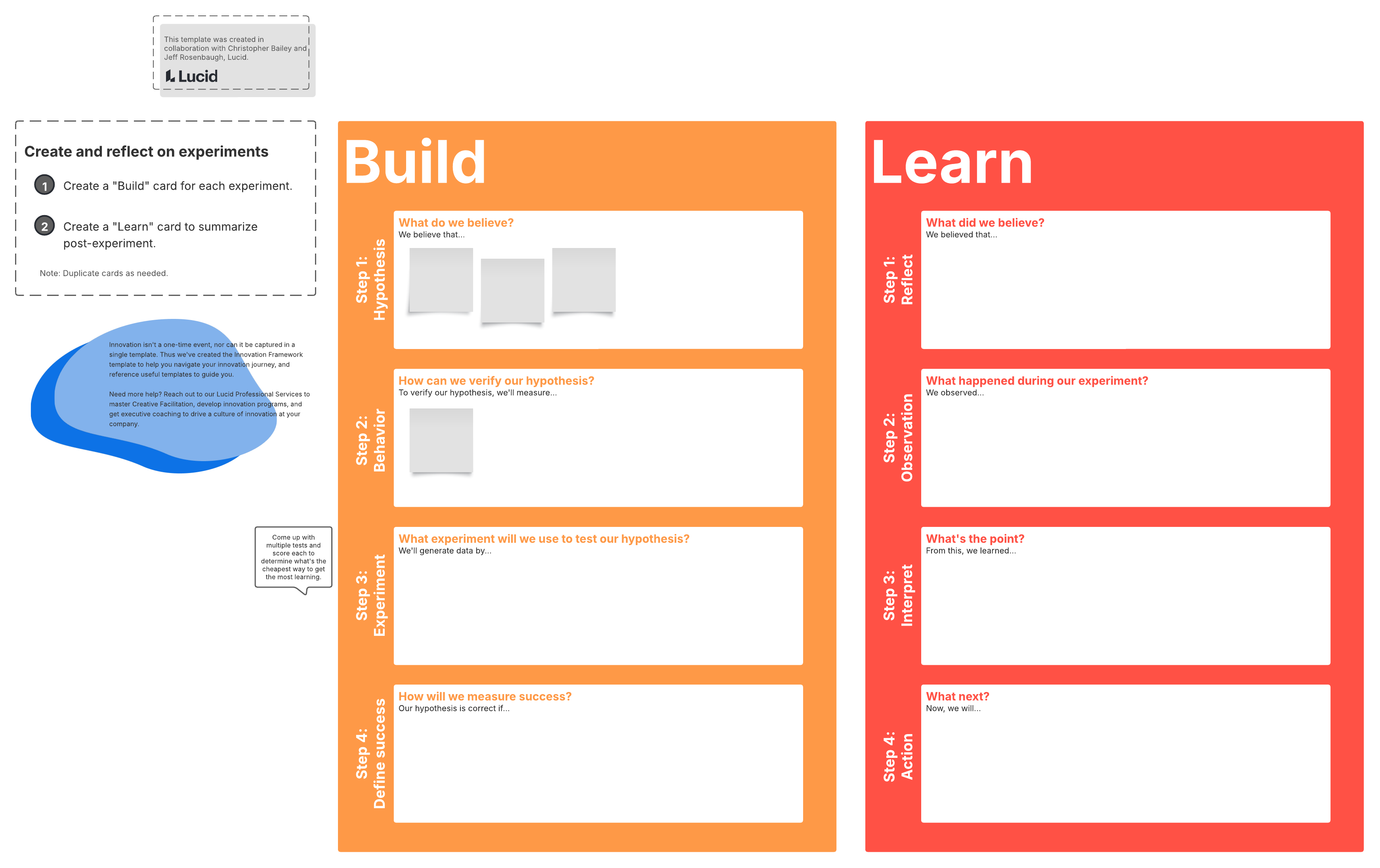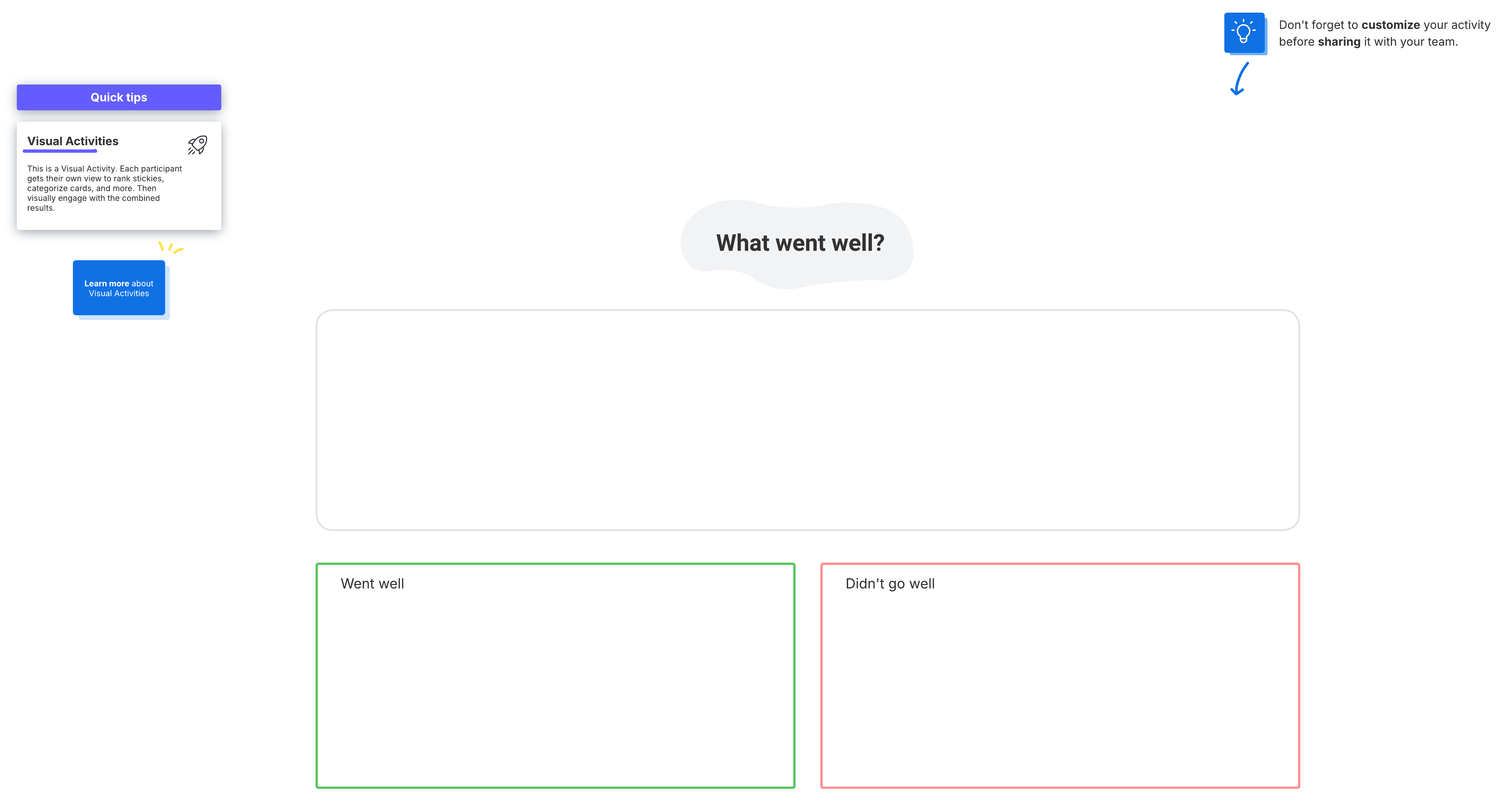
What is the Satir change model? Tips for using the Satir model of change for your business
Reading time: about 8 min
Key takeaways:
-
The Satir change model is a change management framework that guides businesses through the five psychological stages that people experience during periods of transition. The model focuses on the emotional impact of change.
-
There are five stages of the Satir change model: late status quo, resistance, chaos, integration, and new status quo.
-
Tips for effectively applying the Stair model of change include creating a plan, bracing for resistance, encouraging experimentation, and strengthening collaboration.
Disruptive change is a factor that businesses constantly have to contend with. From understanding new technologies such as AI to responding to fluctuating market conditions, it can seem like we live in a constant state of change.
Even if companies have a change management strategy in place, periods of transition can have a significant impact on work performance and employees’ well-being. It’s essential for leaders to consider the emotional aspects of change and people’s natural reactions when work processes are disrupted.
The Satir change model was developed to help businesses take the psychological impact of change into account and guide employees through change more successfully. This change model prioritizes empathy and communication to better support employees’ experiences.
Learn more about the Satir change model and how you can effectively use it to increase engagement and strengthen resilience among your team.
What is the Satir change model?
The Satir change model is a change management framework that describes the five stages of experience an individual (or workforce) has as they undergo change. The model aims to highlight the behavioral and emotional aspects of change initiatives.
The Satir model was created in the 1960s by Virginia Satir, who was a systemic and family therapist. After years of working with corporations and families, Satir developed the five stages that can be applied to both personal and organizational change processes.
The five stages of the Satir change model are:
-
Late status quo, in which routines, processes, and behaviors are stable or predictable. This stage is characterized as a comfort zone, and any disruption is typically met with frustration. Recognizing this stage is crucial because it serves as a baseline for measuring progress.
-
Resistance when a foreign element or disruption is introduced to the late status quo. In this stage, people experience uncertainty, denial, and discomfort as they prefer to maintain their familiar routines. Clear communication and support are essential at this stage as people receive more information about the change and how it will impact them.
-
Chaos as the change begins to be implemented. This stage is characterized by confusion and disorder as people face the unknown and their old processes become ineffective. While this stage can be stressful, it provides opportunity for experimentation and innovation.
-
Integration as the change is solidified and begins to become incorporated into daily processes. Successful integration requires adaptability, collaboration, and support. Leaders should provide opportunities for questions and feedback as people work together to adjust.
-
New status quo, where the change has officially become habitual for individuals. As new work processes are stabilized and maintained for the long term, this stage is where companies should be experiencing the benefits of transformation and identifying ways to improve the management of future changes.

Why choose the Satir change model
Why would a company choose to follow the Satir model over other change management framework models?
The Satir model enables better execution and adoption by prioritizing the impact of change on people. The model also:
-
Allows for customization and can be implemented for changes big or small
-
Focuses on collaboration at every stage with built-in feedback loops
-
Takes into account the psychological impact of change, improving employee engagement during change and reducing resistance
If you want to implement change in a way that encourages empathy and ensures that your initiatives align with long-term goals, try using the Satir change model.
How to apply the Satir model of change
Follow these tips to use the Satir change model effectively.
Assess your current state and create a plan for change
Assessing the current state of the business process you want to change helps you get started with the Satir change model. Remember, the first stage is the late status quo, so you’ll begin by determining what your baseline is and how it’ll look different after the change is implemented.
Use a visual collaboration solution to map out your existing processes and identify how you’ll get from your current state to an ideal future state. By conducting value stream mapping, you can more easily understand potential impacts to existing workflows.

Once you’ve identified what will change, you also need to determine:
-
What resources or tools do people need to accomplish this change?
-
What is the value of the change? How will you know when the change has been successfully implemented?
-
What information should be provided to teams, and how will it be provided?
Your answers to these questions will be the foundation for your change announcement plan. Set goals and define metrics for teams. Timelines are a useful feature for visualizing milestones in your change strategy.
Communicate the reasons for change to all stakeholders and make it clear where people can find the information they need. Teams should also understand how and when they will provide updates on their progress.
Brace for resistance and chaos
As you move from planning change to the implementation stages, leaders should be prepared for some challenges. It’s natural for employees to initially be resistant to change as they often wonder if the change will create more work, negatively impact relationships, or cause them to lose their jobs.
The Satir change model accounts for this fear and confusion. During the resistance and chaos phases of the model, it’s important to have open communication and to maintain morale. Employees will look to leadership for guidance and support, and leaders should be prepared to address any concerns.
Clearly documenting workflows and ensuring that people can easily find resources helps to counter the messiness and disorganization of implementing change. A dedicated team space helps leaders manage chaos by having a central place for resources and questions.

Change is rarely smooth, but making information readily available and encouraging collaboration helps teams adapt.
Facilitate experimentation and training
Successfully implementing change takes a lot of trial and error. The integration phase of the Satir change model is an excellent time to provide training and resources for employees to adopt new work processes. Mistakes will be made as people test out new ways of working—and that’s okay.
Especially during a period of change, it’s beneficial to foster a culture of psychological safety in which people feel safe to try new things and take risks without fear of failure. Leaders should encourage the attitude that this change is an opportunity to learn together as a team. Employees should have the opportunity to experiment with new ways of working and share their results.
There are multiple ways that teams can practice experimentation. You can use build and learn cards, create opportunity solution trees, or use an experiment map to facilitate experimenting and learning.

Establish the new status quo
The last stage of the Satir model is establishing the new status quo. You’ll move from a period of transition to a new normal where the change has become part of daily work processes.
To solidify the change, teams should reinforce new work practices and behaviors. Using customizable templates to document processes makes it easier for people to follow a best practice or new workflow. You can use templates for documenting processes, team structure, and organizational alignment so everyone is on the same page.

As you establish the new status quo, celebrate successes with your team and provide people with the opportunity to provide feedback on how things went. Retrospectives are a great way to facilitate feedback and give people a safe space to express their thoughts. You can ask what didn’t go well, what people learned, and how things could be improved.
Visual Activities are another great way to capture feedback from your team. You can aggregate the results to easily collect information and understand how everyone is feeling.

During this last stage of implementing change, be on the lookout for any skills gaps that appear and ensure that team members remain engaged. There can still be some adjusting and settling as change initiatives are fully integrated throughout the organization.
Maintain continuous adaptation
Maintain the new status quo with continuous adaptation and support. To ensure that change is actually sustained, new employees should be trained on work processes. Tenured team members also should receive training whenever there are updates to processes or responsibilities.
As you sustain the status quo, keep looking for opportunities to improve. Change is constant, and chances are, you’ll have to help teams adapt to change again at some point.
Ask yourself:
-
Could communication be better the next time?
-
Are tenured employees getting the resources they need?
-
How could you streamline the deployment of your change management strategy?
Use the Satir change model to help guide your strategy and improve adaptation over time. By taking into account the psychological impact of change, you can better prepare your employees for inevitable change and enhance resiliency across your organization.
Manage change efficiently with Lucid
Change isn’t easy—but using a framework like the Satir model of change and a visual collaboration solution helps you reduce confusion and hesitation during periods of transition. Lucid provides employees with a central place to find the resources they need and improves collaboration across teams as people come together to face what’s next. Discover more change management tips and get the resources you need to successfully navigate change.

Our guide to organizational change management
Learn effective change management strategies with our in-depth guide.
Get the tipsAbout Lucid
Lucid Software is the leader in visual collaboration and work acceleration, helping teams see and build the future by turning ideas into reality. Its products include the Lucid Visual Collaboration Suite (Lucidchart and Lucidspark) and airfocus. The Lucid Visual Collaboration Suite, combined with powerful accelerators for business agility, cloud, and process transformation, empowers organizations to streamline work, foster alignment, and drive business transformation at scale. airfocus, an AI-powered product management and roadmapping platform, extends these capabilities by helping teams prioritize work, define product strategy, and align execution with business goals. The most used work acceleration platform by the Fortune 500, Lucid's solutions are trusted by more than 100 million users across enterprises worldwide, including Google, GE, and NBC Universal. Lucid partners with leaders such as Google, Atlassian, and Microsoft, and has received numerous awards for its products, growth, and workplace culture.
Related articles
5 organizational change management strategies for a modern workforce
Organizational change management is complex. Learn from Lucid’s experts on how to pull off a company-wide shift.
What is the McKinsey 7-S model?
The McKinsey 7-S framework helps you assess seven key elements of your business that need to change or be aligned in order to be successful.
Change management 101: Strategies and examples
Learn about change management strategies and check out the related Lucidspark templates and examples.
7 fundamental change management models
There are many different ways to approach change management. Learn 7 tried-and-true change management models that organizations return to again and again.
